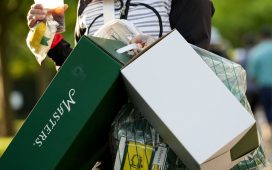Tom Lehman tried to imagine the unthinkable.
The 2021 Waste Management Phoenix Open — a golf event unlike any other — is still months away, but how it might look, with the novel coronavirus continuing to surge, remains unclear. Lehman pondered a dreary scene.
“Imagine going up on the 16th hole and hitting a shot where you bury it in the lip,” the veteran golfer said. “And there’s not any reaction.”
The annual event at TPC Scottsdale is known for its raucous, jam-packed crowds. It can feel like a tailgate party, rock concert, beer festival and sporting event rolled into one. It is a defining event on the Valley’s social calendar, an excuse even for non-golf fans to head to the course and bask in the sunshine.
But no one knows what elements of Phoenix Opens past will be visible the first week of February, when the tournament is scheduled to take place.
For now, organizers expect to go forward with the event. They say it will be scaled down in every respect. Gone will be many of the temporary structures that ran parallel to the course. Organizers hope to have fans, albeit nothing close to the 200,000-plus who typically turn out on Fridays and Saturdays.
They are making no assurances. Rather, they are planning and they are hoping. It is the best they can do.
“I stopped trying to predict what was going to happen this year,” said Scott Jenkins, this year’s tournament chairman. “But we are cautiously optimistic that by the time we get to our event in February that we’ll be in a position to have the event and do so in a safe and responsible manner.”
During a typical November, construction would be more than a month old on the course’s dozens of venues. The work takes four-plus months to complete. Last year, the event featured 28 venues, including the three-level, coliseum-esque enclosure that surrounds No. 16, the event’s iconic hole, and the Bird’s Nest, the event’s party hot spot.
This year, Jenkins said the number of venues might be closer to four or five, intimating that the focus would be on the final three holes. Most likely, that means no Bird’s Nest and a more restrained version of the build at No. 16.
Jenkins said that by spending less on what usually is a “multi-million-dollar infrastructure and venue build” the nonprofit event can still approach its charitable targets.
“Last year, the charity donation was $14 million,” Jenkins said. “The goal is to try to get as close as we can. The need is as great now as it ever has been.”
Still, questions remain about how much organizers can do and how safely they can execute it.
In theory, outside of home, it is hard to think of a safer place as it relates to virus transmission than a golf course. It is outdoors, where studies show spread is lower. It is wide open, perfect for social distancing. Mask wearing would further mitigate spread.
But there still would be opportunity for the virus to thrive, according to Dr. Michael Saag, an infectious diseases expert at the University of Alabama-Birmingham. For starters, there are the pure numbers: With a rate of 40 cases per 100,000 residents — Maricopa County is at 43.6 over the past seven days — Saag said there would be a 99 percent chance that at least one person in a crowd of 100 would be infected.
“The more people you congregate into a given area,” he said, “the more likelihood that one person could be infected and that person could be spreading, even with mitigation around.”
Saag envisioned potential instances when even well-intentioned fans could let their guards down. He imagined two friends in conversation who remove their masks to have drinks of beer. He pictured fans crowded around a pivotal putt on the 18th green, all of them inching closer to get a better look.
“Who’s not going to do that?” he said. “I can’t lean in because I’m within your (six-foot) space? That ain’t going to happen.”
Saag said he has always enjoyed watching the Phoenix Open — “I love watching the people scream on the 16th hole; it’s a riot” — but believes the upcoming tournament needs to be limited to just a tiny fraction of the fans it normally welcomes.
“You don’t want to create a super-spreader event,” Saag said.
Thus far, only a handful of PGA Tour events since the start of the pandemic have included fans. Fans were prohibited from last week’s RSM Classic in Georgia, and several other events in the coming weeks have already announced they will be closed to the public, in large part because the states in which they are held — including Hawaii and California — have stringent restrictions.
The Vivint Houston Open, held earlier this month, was the first Tour event in the U.S. to allow fans, capping the number at just 2,000 per day. The event was a test case of sorts, according to Tyler Dennis, a senior vice president and chief of operations for the PGA Tour, who told Golf Digest the tour would proceed on a tournament-by-tournament basis into the late spring.
“It was fun to have people back,” PGA Tour member Max Homa said. “I think there was a good amount of people — not too many, not too little. It had a great buzz. I didn’t feel unsafe in any way.”
Jenkins said earlier this month that Phoenix Open organizers were cleared by the PGA Tour to move forward with plans for limited attendance, though he acknowledged that could change depending on the circumstances. Tickets have yet to go on sale.
Jenkins expects to seek further approval from the tour as well as city and state officials as the event draws nearer. Local rate of positive cases and hospital capacity, among other factors, are expected to be among the considerations.
Lehman, a Scottsdale resident and former Ryder Cup captain who has played the Phoenix Open 20 times in his career, was asked how different the event would feel without fans.
“Oh my gosh,” he said. “How different would it be? It would be like the NFL playing football with no pads. It would be a completely different animal.”
Said Homa: “I personally think it’s the most fun and the most exciting event. Obviously, there are bigger events, majors and what not, but as far as enjoyment with the cheers and even the heckles — I like all of that. I think all events are losing the general excitement because there’s nobody there or less people there, but that one in particular would be a big hit.”
When the pandemic reached the U.S. earlier this year, the Phoenix Open had been completed just weeks earlier. It seemed possible the calendar would allow it to dodge the worst of the virus-related fallout. Instead, the tournament appears to be rushing headlong into the teeth of the pandemic.
“I think it’s probable,” Saag said, “that the rate of cases toward the end of January are going to be higher — substantially higher — than where they are right now.”
All of which makes the task for event organizers that much more difficult. Tournament details likely will remain fluid over the 2 ½ months remaining until the event.
“Our tournament is known as the ‘People’s Open,’” Jenkins said, “so having people at the people’s open has been extremely important to our group and our community. Our focus is on doing it in the safest possible way. Masks will be mandatory. We have some great health and safety sponsors that are helping us put together our safety protocols to make sure people can still have a great time but are doing it in a safe and responsible manner.”








